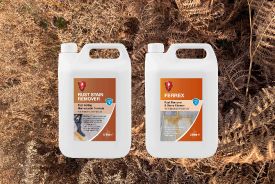
Rust is one of the most difficult types of stain to remove – but did you know there are two different types? The first is caused by external sources, whilst the second is caused by a chemical reaction within a stone – and each needs to be treated with a different type of stain remover.
External rust stains
Most rust stains are caused by metal objects and they’re particularly common in places where metal comes into contact with moisture. Metal towel rails, weighing scales, soap dishes, jugs and containers, toilet roll stands and candle holders are common culprits in the home. Outside, marks are often left by firepits, BBQ’s, garden tools, toys and bikes, pots and parasol stands. The stains are caused by tiny deposits of iron that wash off the surface of the object when it comes into contact with moisture or water; these deposits then leave a rust stain. In addition, some weed killers also contain ferric sulphate which can cause rust stains.
Internal rust stains
Rust or orange-coloured discolouration can appear naturally within hard ferrous-type stone pavers, including sandstone, slate and granite. These stones naturally contain iron which can oxidise or rust when it comes into contact with rain. Washing a patio with excessive amounts of water – for example, with a jet wash or patio cleaner – can also cause this reaction, as can some cleaning products. This type of staining is often referred to as ‘iron break-out’.
Certain acidic cleaners, like brick acid and cement removers, also contain ingredients that can stain/damage limestone and sandstone pavers, and can accelerate oxidisation in hard ferrous stone. Ironically, these same products are often used to remove rust marks and can create an even greater problem.
Each type of rust – internal and external – needs to be treated differently for effective removal of the stain. We recommend one of two products – LTP Rust Stain Remover or LTP Ferrex, both of which can also be used indoors and outdoors.

LTP Rust Stain Remover is a non-caustic solution that removes marks caused by external sources. It is safe to use on all polished and unpolished natural and artificial stone tiles, including marble, granite, travertine, split face stone cladding, sandstone, concrete, terracotta, ceramic and porcelain. After applying, the reaction between the rust stain and the treatment causes it to turn purple, so you can clearly see the product working. More stubborn stains may need more than one treatment. If this is the case, we recommend leaving 15 minutes after the first dosing, then removing the rust residue with a sponge or water and repeating until all of the ‘purpling’ has stopped. Once there is no colour reaction, all of the iron has been removed. Here’s a link to more information, including a Video Aid which shows the treatment being applied, step by step. You can also see a short demo on our YouTube Channel, LTP TV, showing treatment on a porcelain paver.
How to apply LTP Rust Stain Remover
- Ensure that the surface to be treated is completely free from dust and dirt before application. If necessary, wash with LTP Power Stripper diluted 1:10 with water.
- SHAKE WELL BEFORE USE. Do not dilute. Completely cover the rust stain with the product. Leave to act for 15 minutes. The product colour will change to a deep purple as it reacts with the rust. Once the indicated time has elapsed, remove the residue and rinse the surface thoroughly with plenty of water and leave to dry. Repeat application until the stain is completely removed.
The second treatment, LTP Ferrex is formulated to remove the rust stains that arise from within the stone, caused by the naturally occurring particles of iron. It’s designed for hard ferrous stones including sandstone, granite and slate. Ferrex is an acid-based cleaner but it’s the right kind of acid for harder stones. However, it is not suitable for use on acid sensitive surfaces, including limestone, marble or pavers with a highly polished finish. It’s worth diluting the product with water before use and testing it at different strengths on an inconspicuous area; in this way, you can see which dilution suits your tile best before treating the whole surface. Here’s a link for more information on application and dilutions. You can also see a Video Aid on the product page and on LTP TV. Treatment to remove these types of stain can take between 3-6 hours. The reaction won’t be visible like it is LTP Rust Stain Remover; the treatment should be left to work and no agitation is generally needed. Once the staining has disappeared, rinse well with water and leave the pavers to dry.
How to apply LTP Ferrex
- After testing on a small area, apply the solution to the surface and spread out evenly. For external applications garden sprayers can be used.
- For severe staining, surfaces should be agitated using a short haired scrubbing brush or black emulsifying pad.
- After 3 – 6 hours, rinse with plenty of clean water. If traces remain after a couple of days, repeat the process.
- After treatment, we recommend that the surface is protected from water with an impregnating sealer like LTP External Stone Sealer or LTP Mattstone H20. This will greatly reduce the risk of rust discolouration returning.
Some natural stones will appear darker after treatment, as the product continues to work following the initial application. This is normal and the darkening effect will gradually subside.
For more advice, visit our blog section on the website, browse LTP TV on YouTube or https://www.ltp-online.co.uk. To contact the LTP team direct, call 01823 666213 or email [email protected]



